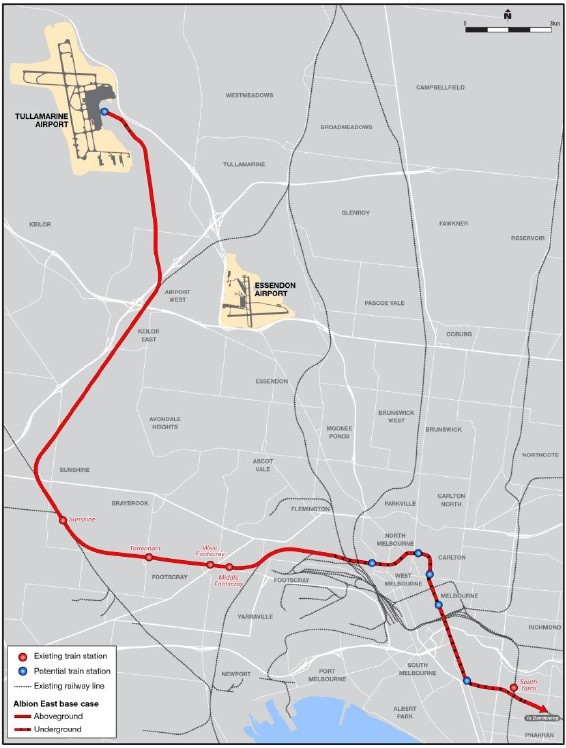
Back in October I said I was surprised that no Victorian Government had ever caved into the intense public pressure to build a rail line between the airport and the CBD (see Could Melbourne airport have rail sooner rather than later?).
It’s not the sensible thing to do at this time, but it’s an extraordinarily popular idea that’s been pushed enthusiastically by the Fairfax press. So it’s surprising it hasn’t happened given State Governments are renowned for choosing the opportunistic option over the sensible option.
Well, all is now right with the world. The Premier of Victoria, Denis Napthine, announced today (Sunday 13 April) that if his Government is re-elected on 29 November 2014 he’ll get on with building an electrified rail line to Southern Cross station.
There’s little detail on the important technicalities, although we’re told the journey will take 25 minutes and services will run every 10 minutes in peak hour. (1) The important point is Public Transport Minister Terry Mulder says the commitment to the project is “secured in the upcoming State Budget”.
The Government went to the 2010 election promising to conduct a feasibility study of an airport line. It duly completed the study (see Trains: should the ‘where’ come before the ‘why’?) but announced that the line couldn’t be built until the Melbourne Metro was completed; the Metro would provide additional rail capacity so the airport line could connect with the metropolitan rail network.
But today’s announcement is an acknowledgement that the Metro is no longer seen as a constraint. Instead of tying in with the metropolitan train system, the new proposal envisages a mostly dedicated line terminating in the CBD at Southern Cross Station.
The about-face is also another sign, following the reduction in Zone 2 fares announced a few weeks ago (see Lower fares are good politics, but are they good policy?), that the Government is rattled, particularly in relation to its performance on public transport.
Some argue its commitment to the East West Link motorway has alienated voters. I disagree; I think the idea of new roads generally plays well with many suburban voters. The Government’s problem is that it’s permitted its unbridled enthusiasm for the new motorway to be portrayed as evidence that it’s anti-public transport.
Just how the Government is going to convince the electorate that it’s really, really fair dinkum this time is a puzzle. As well as airport rail and Melbourne Metro, it’s also done studies of new lines to Doncaster, Rowville, and Avalon, but so far nothing concrete has happened.
The airport rail line still needs a lot of design at the front-end to avoid big cost blow-outs later on. It will be hard for the Government to budget responsibly in this year’s budget for anything more than development work. Even $50 million won’t convince anyone they’re serious.
But apart from being politically useful, does building airport rail make good sense?
According to the Government’s own feasibility study of the airport line, rail to airports is justified on operational grounds when passenger volumes though the airport reach around 60 million p.a. However Melbourne Airport currently handles around 30 million p.a. and doesn’t expect to reach 60 million p.a. until after 2030.
SkyBus already offers an outstanding service between the airport and Southern Cross station. It’s true most travellers seem to find trains more comfortable than buses, but SkyBus operates 24 hours a day at 10 minute frequencies for most of that time. It provides a 20 minute trip off-peak and a 40 minute trip in the peak.
Airport rail is likely to cost at least $2-3 billion. That’ll be a large impost on the State budget and will inevitably delay other projects like Melbourne Metro, signalling upgrades, and the extension of rail to the outer suburban growth area of Mernda.
Melbourne Metro is a strategically valuable project aimed at increasing system capacity. Without it, the rail system will not be able to support continued growth of employment in the CBD.
While Dr Napthine says the airport train will operate at 10 minute frequencies in the peak, that’s not likely in the off-peak. Brisbane’s Airtrain, which is similar in that it also terminates at an airport, only offers 30 minute frequencies in the off-peak. Moreover the last service leaves the city at 9:30 pm and departs the airport at 10:00 pm. (2)
A big disadvantage of “going now” is the loss of a connection with the Melbourne Metro. Since the two lines could share infrastructure at the city end, it would reduce the cost of providing the airport rail line.
More importantly, it would also bring airport passengers into the heart of the CBD (via new stations at Melbourne Central and Flinders Street). Further, it would provide a one-seat rail journey for airport travellers going beyond the CBD to the populous south-eastern suburbs; now they’ll have to change trains at Southern Cross.
The Government of the day would of course have the option of connecting the airport line to Melbourne Metro if and when the latter is built, but retrofitting would be more expensive.
The bottom line is airport rail simply isn’t needed yet. In light of SkyBus’s ability to increase frequencies as demand grows, the benefits from bringing rail forward by 10-15 years don’t justify the costs (also see Does every city need an airport rail line?).
As I’ve noted before, replacing one form of public transport (bus) with another (rail) offers limited benefits. It will be appropriate when demand warrants investing in a higher capacity mode (see Does every city need an airport rail line?) but on current projections that won’t be until after 2030.
Building airport rail in line with demand would enable it to be linked with the proposed Melbourne Metro and offer operational benefits. As it stands, the Government’s decision to go with airport rail first will very likely crowd out Melbourne Metro.
The Government should continue to improve on-road priority for SkyBus in peak traffic periods until such time as demand at the airport justifies constructing mass transit.
________________________________
- I’m non-plussed by the Premier’s claim the train trip will be 25 minutes. The Government’s own feasibility study put it at 30 minutes (50% slower than SkyBus off-peak) so I’d be interested to hear how Dr Napthine’s managed to reduce it. Seems like an enormous achievement!
- Sydney’s Airport Link train has very high frequencies, but the airport is close to the CBD and trains travel beyond it to service suburban Sydney.








Crikey is committed to hosting lively discussions. Help us keep the conversation useful, interesting and welcoming. We aim to publish comments quickly in the interest of promoting robust conversation, but we’re a small team and we deploy filters to protect against legal risk. Occasionally your comment may be held up while we review, but we’re working as fast as we can to keep the conversation rolling.
The Crikey comment section is members-only content. Please subscribe to leave a comment.
The Crikey comment section is members-only content. Please login to leave a comment.